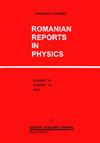一种新型染料向列液晶复合材料的高效随机激光效应
IF 2.2
4区 物理与天体物理
Q2 PHYSICS, MULTIDISCIPLINARY
引用次数: 5
摘要
近十年来,具有有机和无机性质的完全无序系统中的随机激光效应已成为广泛研究的主题。在多重散射材料中,光扩散可引起光子输运行为的相变。超过临界散射水平,系统过渡到强局域状态,因此光传输被抑制。这种效应可以用作光子捕获机制,在增益介质存在的情况下获得激光作用。本文首次在具有负介电各向异性的染料掺杂向列相液晶(ZLI-2659)中提供了随机激光作用的实验证据。这种材料表现出远距离的介电张量波动,有利于多次散射。当超过一定阈值泵浦功率时,系统中的荧光曲线崩溃,在剩余自发发射光谱上方出现明显的尖峰。激光发射具有几个有趣的特征-激光峰的线宽是极窄的带状(约0.5nm FWHM),极低的阈值(30µJ/mm 2),高效率(~ 20%)。在染料发射光子的多次重复散射事件中,不可预见的建设性干涉的存在为向列液晶系统中的激光提供了必要的光学反馈。我们分析了这些相对新颖的现象的主要物理特征,同时也包括了活性介质的各种约束几何的情况。这些科学方面忽略了激光物理和材料科学的重要特征。本文章由计算机程序翻译,如有差异,请以英文原文为准。
Efficient random laser effect in a new dye-nematic liquid crystalline composite
Random lasing effects in fully disordered systems with organic and inorganic nature have been the subject of extensive studies since the beginning of the past decade. In multiple scattering materials the optical diffusion may induce a phase transition in the photon transport behavior. Beyond a critical scattering level, the system makes a transition into a strongly localized state and light transmission is therefore inhibited. This effect can be used as a photon trapping mechanism to obtain laser action in the presence of a gain medium. In this paper we present the first experimental evidence of random laser action in a dye doped nematic liquid crystal (ZLI-2659) with negative dielectric anisotropy. This material exhibits long-range dielectric tensor fluctuations, favoring the multiple scattering. When exceeding a certain threshold pump power value, the fluorescence curve in the system collapses and distinct sharp peaks emerge above the residual spontaneous emission spectrum. The laser emission has several interesting features - linewidth of the laser peaks is extremely narrow banded (approximately 0.5nm FWHM), very low threshold (30 µJ/mm 2 ), high efficiency (~ 20%). The unforeseen surviving of constructive interference in repeated multiple scattering events of the dye emitted photons provide the necessary optical feedback for lasing in our nematic liquid crystalline system. We analyze the main physical characteristics of these relatively novel phenomena, by also including here the case of various confinement geometries for the active medium. These scientific aspects overlook features of great interest characteristic of laser physics and material science.
求助全文
通过发布文献求助,成功后即可免费获取论文全文。
去求助
来源期刊

Romanian Reports in Physics
物理-物理:综合
CiteScore
4.20
自引率
29.60%
发文量
0
审稿时长
4-8 weeks
期刊介绍:
Romanian Reports in Physics is a journal publishing physics contributions in the fields of:
1. Mathematical and General Physics
2. Nuclear Physics. Particle Physics. Astroparticle Physics
3. Atomic and Molecular Physics
4. Plasma Physics
5. Condensed Matter
6. Optics & Quantum Electronics
7. Biophysics & Medical Physics. Environmental Physics
8. Physical Methods and Instrumentation
9. Earth Physics
 求助内容:
求助内容: 应助结果提醒方式:
应助结果提醒方式:


